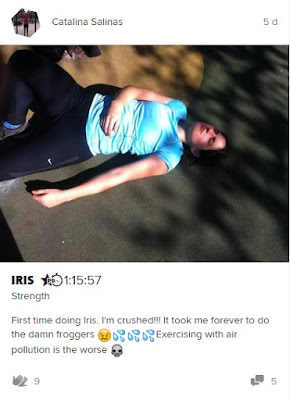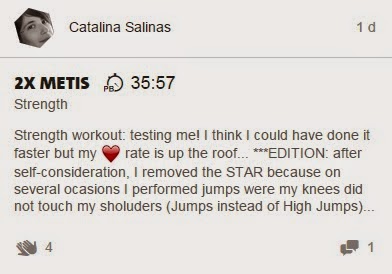Well hello hello everybody! As I said in my last post, I've been like crazy with work and extracurricular activities... I thought things were calming down but it has not been the case. I actually enrolled in a night class once a week, so I have even less time than before! I've kept on training but not as much as I would like to (and should), and I had intended to write about that. Now, let me explain why my training volume has gone so low in the past weeks, other than because I am busy and unfocused.
These past three weeks have been really hard here in Santiago in terms of air pollution. For those of you who read this from distant latitudes, I'll have you know that Santiago is the capital city of Chile, and with 15.403 km2, it only represents 2% of the country's total area. However, about 40% of the population (that is over 6 million people, including myself) lives in that 2% area, so you can imagine... It's nowhere near Hong Kong or Tokyo crowded, but still, that's a lot of people in a rather small space.
The city was founded in 1541 by the Spanish conqueror Pedro de Valdivia, and taking that into consideration, well, it was build in a valley, secluded and protected by the Andes mountains and hills. That was great when you were under attack and had to get cover to save your life, but almost five centuries later, with gazillions of cars and factories and inhabitants, this location turned out to be a pretty lousy one. We are so secluded by the mountains that there are awful ventilation conditions. Every winter, when the air gets colder and lowers closer to the ground (basic physics, hot air goes up, cold air goes down), we have a large accumulation of smog. This year particularly, it has not rained AT ALL. We have had two or three days with a couple of raindrops, barely enough to damp the streets, and definitely insufficient to clean the air. For the first time in 16 year the government had to declare "environmental emergency" on June 22nd. That day we had over 500 µg/m3/hour of PM2,5 which is Particulate Matter that's smaller than 2,5 micrometers, and therefore can get all the way inside you alveoli and cause severe respiratory troubles. It's basically breathing dust and smoke with particles small enough that they can penetrate into your lungs. That's definitely unhealthy, specially for those at higher risk (infants, elderly and people with respiratory diseases).
As you can imagine, training with this amount of pollution has been a struggle. I'm trying to be healthier here, leading a sporty life, and I'm torn between exercising while breathing that sh#tty air and not exercising at all. Since I'm doing a lot of activities outside work, there are only certain days I can go out and train at night with reasonable time ahead of me, so what do I do when there's pre-emergengy or emergency conditions and I have to run 2 km???
Writing this, and being the scientist that I am, has made me search a little bit more information about the subject on the web. It turns out that the World Health Organization (WHO) states that average hourly values under 25 µg/m3/h of PM 2.5 are considered safe (see here)... and here we are, having ten and even twenty more times!!! The Chilean law states that up to 99 µg/m3/h are considered good measurments (safe), up to 199 µg/m3/h regular, up to 299 µg/m3/h alert, up to 499 µg/m3/h pre-emergency and over 500 µg/m3/h emergency. There's a lot to take into consideration when declaring there's an emergency, like closing factories and prohibiting the use of cars (we have a system where according to the number your license plate finishes in, you are forbidden to drive on pre-emergency and emergency), but I think that the set values should be WAAAAAY lower. It seems unreasonable to me to wait until we get twenty times above the safe limit to establish an emergency situation. I red here that the government is intending to slowly lower these numbers to comply with the WHO recommendations by 2032!!! That's nearly 17 more years of breathing sh*tty air, every winter... You can imagine, I'm not pleased about these findings.
As you can imagine, training with this amount of pollution has been a struggle. I'm trying to be healthier here, leading a sporty life, and I'm torn between exercising while breathing that sh#tty air and not exercising at all. Since I'm doing a lot of activities outside work, there are only certain days I can go out and train at night with reasonable time ahead of me, so what do I do when there's pre-emergengy or emergency conditions and I have to run 2 km???
Writing this, and being the scientist that I am, has made me search a little bit more information about the subject on the web. It turns out that the World Health Organization (WHO) states that average hourly values under 25 µg/m3/h of PM 2.5 are considered safe (see here)... and here we are, having ten and even twenty more times!!! The Chilean law states that up to 99 µg/m3/h are considered good measurments (safe), up to 199 µg/m3/h regular, up to 299 µg/m3/h alert, up to 499 µg/m3/h pre-emergency and over 500 µg/m3/h emergency. There's a lot to take into consideration when declaring there's an emergency, like closing factories and prohibiting the use of cars (we have a system where according to the number your license plate finishes in, you are forbidden to drive on pre-emergency and emergency), but I think that the set values should be WAAAAAY lower. It seems unreasonable to me to wait until we get twenty times above the safe limit to establish an emergency situation. I red here that the government is intending to slowly lower these numbers to comply with the WHO recommendations by 2032!!! That's nearly 17 more years of breathing sh*tty air, every winter... You can imagine, I'm not pleased about these findings.
I went out and run my 2 km (2 x 1 km) from Iris on a day there was pre-emergency. It was on Saturday, the day I usually train with my group in the park. I regret having run that day. I don't know if it was psychological or not, but I felt I had trouble oxigenating properly... After finishing the workout I started coughing my lungs off, and I even had a bit of dusty phlegm that afternoon; absolutely disgusting! After that, I made the decision of not training at all with emergency levels, and on alert and pre-emergency days to only do the new 2x2 workouts, indoors. For those of you who haven't heard, the 2x2 is a new feature that was introduced in the Freeletics Coach about two weeks ago (quite conveniently for me right now) that modifies the workouts that require a given space and running distance so that you can perform them in 2 x 2 meters (basically anywhere). I haven't had the opportunity to test it, but my next workout is Iris again, so I'll let you know how the 2x2 thing works out.












